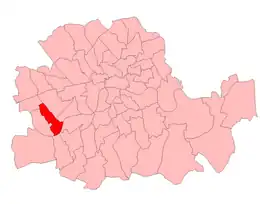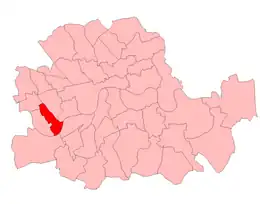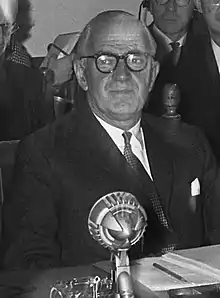Fulham East (UK Parliament constituency)
Fulham East was a borough constituency in the Metropolitan Borough of Fulham in London. It was represented in the House of Commons of the Parliament of the United Kingdom from 1918 to 1955. Elections were held using the first-past-the-post voting system.

Fulham East in the County of London, boundaries 1918-50

A map showing the wards of Fulham Metropolitan Borough as they appeared in 1916.

Fulham East in the County of London, boundaries 1950-55
| Fulham East | |
|---|---|
| Former Borough constituency for the House of Commons | |
| County | Metropolitan Borough of Fulham (in the County of London) |
| 1918–1955 | |
| Seats | One |
| Created from | Fulham |
| Replaced by | Fulham |
At the 1918 general election the previous Fulham constituency was divided into two constituencies, Fulham East and Fulham West; the two halves were re-united for the 1955 general election. At the 1997 general election, the Fulham constituency was replaced by Hammersmith and Fulham.
Boundaries
The Metropolitan Borough of Fulham wards of Barons Court, Lillie, Sands End, and Walham.
Members of Parliament
| Election | Member[1] | Party | |
|---|---|---|---|
| 1918 | Henry Norris | Unionist | |
| 1922 | Kenyon Vaughan-Morgan | Unionist | |
| 1933 b-e | John Wilmot | Labour | |
| 1935 | William Astor | Conservative | |
| 1945 | Michael Stewart | Labour | |
| 1955 | constituency abolished: see Fulham | ||
Election results
Election in the 1910s
| Party | Candidate | Votes | % | ±% | |
|---|---|---|---|---|---|
| C | Unionist | Henry Norris | 10,242 | 69.4 | |
| Independent Labour | David Cook | 2,883 | 19.5 | ||
| Liberal | Frederick L. Coysh | 1,644 | 11.1 | ||
| Majority | 7,359 | 49.9 | |||
| Turnout | 14,769 | 40.8 | |||
| Registered electors | 36,228 | ||||
| Unionist win (new seat) | |||||
| C indicates candidate endorsed by the coalition government. | |||||
Election in the 1920s
| Party | Candidate | Votes | % | ±% | |
|---|---|---|---|---|---|
| Unionist | Kenyon Vaughan-Morgan | 13,282 | 61.5 | −7.9 | |
| Labour | John Palmer | 5,393 | 35.0 | New | |
| Liberal | Maurice Gordon Liverman | 2,907 | 13.5 | +2.4 | |
| Majority | 7,889 | 36.5 | −13.4 | ||
| Turnout | 21,582 | 58.0 | +17.2 | ||
| Registered electors | 37,180 | ||||
| Unionist hold | Swing | −5.2 | |||
| Party | Candidate | Votes | % | ±% | |
|---|---|---|---|---|---|
| Unionist | Kenyon Vaughan-Morgan | 9,757 | 43.9 | −17.6 | |
| Labour | John Palmer | 7,683 | 34.5 | -0.5 | |
| Liberal | Robert Crawford Hawkin | 4,817 | 21.6 | +8.1 | |
| Majority | 2,074 | 9.4 | −27.1 | ||
| Turnout | 22,257 | 58.0 | 0.0 | ||
| Registered electors | 38,403 | ||||
| Unionist hold | Swing | −13.6 | |||
| Party | Candidate | Votes | % | ±% | |
|---|---|---|---|---|---|
| Unionist | Kenyon Vaughan-Morgan | 16,657 | 61.6 | +17.7 | |
| Labour | John Palmer | 10,403 | 38.4 | +3.9 | |
| Majority | 6,254 | 23.2 | +13.8 | ||
| Turnout | 27,060 | 69.1 | +11.1 | ||
| Registered electors | 39,151 | ||||
| Unionist hold | Swing | +6.9 | |||
| Party | Candidate | Votes | % | ±% | |
|---|---|---|---|---|---|
| Unionist | Kenyon Vaughan-Morgan | 15,130 | 44.3 | −17.3 | |
| Labour | John Palmer | 13,425 | 39.4 | +1.0 | |
| Liberal | John Henry Greenwood | 5,551 | 16.3 | New | |
| Majority | 1,705 | 4.9 | −18.3 | ||
| Turnout | 34,106 | 66.8 | −2.3 | ||
| Registered electors | 51,066 | ||||
| Unionist hold | Swing | −9.2 | |||
Election in the 1930s
| Party | Candidate | Votes | % | ±% | |
|---|---|---|---|---|---|
| Conservative | Kenyon Vaughan-Morgan | 23,438 | 68.7 | +14.4 | |
| Labour | John Maynard | 8,917 | 26.1 | -13.3 | |
| Liberal | John Henry Greenwood | 1,788 | 5.2 | -11.1 | |
| Majority | 14,521 | 42.6 | +37.7 | ||
| Turnout | 34,143 | 66.1 | -0.5 | ||
| Conservative hold | Swing | ||||
| Party | Candidate | Votes | % | ±% | |
|---|---|---|---|---|---|
| Labour | John Wilmot | 17,790 | 57.9 | +31.8 | |
| Conservative | William James Waldron | 12,950 | 42.1 | -26.6 | |
| Majority | 4,840 | 15.8 | N/A | ||
| Turnout | 30,740 | 59.5 | -7.6 | ||
| Labour gain from Conservative | Swing | +29.2 | |||
| Party | Candidate | Votes | % | ±% | |
|---|---|---|---|---|---|
| Conservative | William Astor | 18,743 | 51.4 | -16.3 | |
| Labour | John Wilmot | 17,689 | 48.6 | +22.5 | |
| Majority | 1,054 | 2.8 | N/A | ||
| Turnout | 37,433 | 71.9 | +5.8 | ||
| Conservative gain from Labour | Swing | ||||
Election in the 1940s
| Party | Candidate | Votes | % | ±% | |
|---|---|---|---|---|---|
| Labour | Michael Stewart | 15,662 | 55.4 | +6.8 | |
| Conservative | William Astor | 10,309 | 36.4 | -15.0 | |
| Liberal | Philip Montague Syrett | 2,315 | 8.2 | New | |
| Majority | 5,353 | 19.0 | N/A | ||
| Turnout | 28,286 | ||||
| Labour gain from Conservative | Swing | ||||
Elections in the 1950s
| Party | Candidate | Votes | % | ±% | |
|---|---|---|---|---|---|
| Labour | Michael Stewart | 18,998 | 50.1 | -5.3 | |
| Conservative | Vyvyan Adams | 16,233 | 42.9 | +6.5 | |
| Liberal | Frank Victor Jacoby | 2,214 | 5.9 | -2.3 | |
| Communist | Roy Ellwood Elsmere | 399 | 1.1 | New | |
| Majority | 2,765 | 7.2 | -11.8 | ||
| Turnout | 37,764 | 84.2 | |||
| Labour hold | Swing | ||||

Michael Stewart
| Party | Candidate | Votes | % | ±% | |
|---|---|---|---|---|---|
| Labour | Michael Stewart | 20,279 | 53.2 | +3.1 | |
| Conservative | John Hall | 17,806 | 46.8 | +3.9 | |
| Majority | 2,473 | 6.4 | -0.8 | ||
| Turnout | 38,085 | 84.5 | +0.3 | ||
| Labour hold | Swing | ||||
References
- Leigh Rayment's Historical List of MPs – Constituencies beginning with "F"
- British parliamentary election results, 1918-1949, Fred W. S. Craig
- British parliamentary election results, 1918-1949, Fred W. S. Craig
- British parliamentary election results, 1918-1949, Fred W. S. Craig
- British parliamentary election results, 1918-1949, Fred W. S. Craig
- British parliamentary election results, 1918-1949, Fred W. S. Craig
- British parliamentary election results, 1918-1949, Fred W. S. Craig
- British parliamentary election results, 1918-1949, Fred W. S. Craig
- British parliamentary election results, 1918-1949, Fred W. S. Craig
- "The General Election: Last Night's Results". The Times. 24 February 1950. p. 8.
This article is issued from Wikipedia. The text is licensed under Creative Commons - Attribution - Sharealike. Additional terms may apply for the media files.